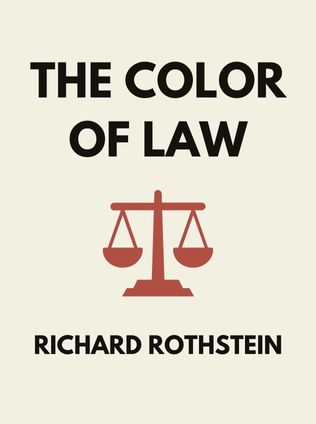
The Color Of Law
A Forgotten History of How Our Government Segregated America
By Richard Rothstein
Published 05/2017
About the Author
Richard Rothstein is a distinguished author and researcher who has dedicated much of his career to studying and documenting the intricate and often painful history of racial segregation in the United States. As a senior fellow at the Economic Policy Institute and a research associate at the Haas Institute at the University of California, Berkeley, Rothstein has meticulously explored how government policies have shaped the landscape of American society, particularly concerning housing and education. His work is a vital contribution to understanding the systemic inequalities that continue to impact African Americans today.
Rothstein’s commitment to uncovering the truths about America’s racial history is evident in his writing style, which blends thorough research with clear, persuasive argumentation. His book, The Color of Law: A Forgotten History of How Our Government Segregated America, is a pivotal work that challenges the common narrative that segregation in America was a result of private choices rather than government policies. Instead, Rothstein meticulously shows that racial residential segregation was not just a social phenomenon but one deeply entrenched in the legal framework of the country.
Main Idea
In The Color of Law, Rothstein argues that the widespread racial segregation seen in American cities is the direct result of de jure (by law) rather than de facto (by fact) policies. Contrary to the popular belief that segregation occurred through private choices and economic factors, Rothstein reveals that government actions at the federal, state, and local levels were instrumental in creating and maintaining segregated communities. This segregation, he contends, violated constitutional rights, particularly the Thirteenth, Fourteenth, and Fifth Amendments, and its effects are still felt in the deep racial inequalities that persist in America today.
Table of Contents
- Introduction: The Myth of De Facto Segregation
- Public Housing as a Segregating Agent
- Exclusionary Zoning Laws
- Federal Loan Discrimination
- Private Sector Abuses
- The Failures of the IRS and Other Government Agencies
- The Role of Localities
- Labor Market Discrimination and Residential Segregation
- Enduring Challenges
- Potential Remedies
Introduction: The Myth of De Facto Segregation
Rothstein begins by dismantling the widely accepted belief that racial segregation in American cities is the result of de facto circumstances—such as individual preferences or economic status. Instead, he argues convincingly that segregation was enforced through de jure policies, where government laws and regulations intentionally discriminated against African Americans, forcing them into ghettos and preventing their movement into predominantly white neighborhoods. This distinction is crucial because de jure segregation, unlike de facto segregation, is unconstitutional.
"The Color of Law shows that the segregation of black Americans into ghettos is not merely the result of innocent private choices or of the unintended consequences of economic forces but is rather the explicit result of public policy." — Richard Rothstein
Rothstein’s approach forces readers to confront the uncomfortable reality that the government, which should have been a protector of civil rights, was instead a key perpetrator of racial discrimination. This foundational argument sets the stage for the detailed analysis that follows, where he examines the various ways in which the state entrenched racial divides through housing policies.
Public Housing as a Segregating Agent
One of the primary methods by which the government enforced racial segregation was through the construction and management of public housing. Rothstein details how public housing projects, initially created to address housing shortages during and after World War I, were used to segregate African Americans from whites. Public housing authorities across the country constructed separate projects for black and white families, often placing African Americans in substandard housing in less desirable areas.
The policy known as the “neighborhood composition rule” was particularly insidious, requiring that public housing reflect the racial composition of the surrounding neighborhood. This rule ensured that African American families were confined to specific areas, reinforcing the segregation that already existed due to discriminatory housing practices.
Sign up for FREE and get access to 1,400+ books summaries.
You May Also Like
Rich Dad Poor Dad
What the Rich Teach Their Kids About Money - That the Poor and Middle Class Do Not!
By Robert T. KiyosakiFreakonomics
A Rogue Economist Explores the Hidden Side of Everything
By Steven D. Levitt and Stephen J. DubnerI Am Malala
The Story of the Girl Who Stood Up for Education and Was Shot by the Taliban
By Malala YousafzaiFactfulness
Ten Reasons We're Wrong About the World – and Why Things Are Better Than You Think
By Hans Rosling



















